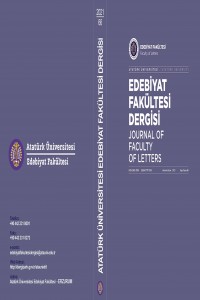Öz
Proverbs give us information about many subjects like daily life, culture, habits, family relations of a nation from the very beginning of their existence. It is also a bridge of culture between the past and the future. In this study, it is aimed to determine the sentence structures of proverbs called “nart söz” in Karachay-Balkar Language, which is a subgroup of Northwestern Common Turkic Languages, and show the differences and similarities between them and Turkey Turkish in the field of syntax. In the study, 132 proverbs were classified. The sentence structure of the proverbs analyzed as follows: 1. Simple Sentence, 2. Complex Sentence, 2.1. Conditional Complex Sentence 2.2. Nested Complex Sentence, 3. Sequential Sentence, 4. Conjunctive sentence. While any proverb made using sentence structure with “ki (i.e. that)” in the studied works cannot be detected, it has been observed that the proverbs made using simple sentence structure and sequential sentence structure are more than others.
Anahtar Kelimeler
Kaynakça
- Aktan, Bilal (2016). Türkiye Türkçesinin Söz Dizimi, Konya: Eğitim Yayınevi.
- Aktan, Bilal (2011). “Cümle Yapısı Bakımından Özbek Atasözleri”. Electronic Turkish Studies, 6(2).
- Aliylanı, S. (1963). Karaçay Nart Sözle, Çerkessk: Karaçay–Çerkes Kitab İzdatelstvo.
- Baskakov, Nikolay Aleksandroviç (2017). Çağdaş Türkçede Cümle. Oktay Selim Karaca (çev.), Ankara: TDK Yayınları.
- Baskakov, Nikolay Aleksandroviç (2016). Çağdaş Türkçede Kelime Grupları. Oktay Selim Karaca (çev.), İstanbul: Kesit Yayınları.
- Baskakov, Nikolay Aleksandroviç (1966). Karaçay-Malkar Tilni Grammatikası, Nalçik: Kabartı-Malkar Kitab Basma.
- Bayramkullanı A. M. ve Orusbiylanı İ. H. M. (1977). Karaçay Tilni Grammatikası, Çerkessk: Stavropol Kitab Basmanı.
- Curtubaylanı H. Ç. (2005). Karaçay-Malkar Nart Sözle, Nalçik: Elbrus Kitap Basma.
- Çobanoğlu, Özkul (2004). Türk Dünyası Ortak Atasözleri Sözlüğü, Ankara: Atatürk Kültür Merkezi Kurumu.
- Delice, İbrahim (2003). Türkçe Sözdizimi, İstanbul: Kitabevi Yayınları.
- Ergin, Muharrem (2007). Türk Dil Bilgisi, İstanbul: Bayrak Yayınları.
- Hadjieva, T. (1996). Karaçay-Malkar Folklor, Red: Dodulanı Aminat, Nalçik: EL-FA Basma.
- Hatipoğlu, Vecihe (1972). Türkçenin Sözdizimi, Ankara: Türk Dil Kurumu Yayınları.
- Karaağaç, Günay (2009). Türkçenin Sözdizimi, 2.Baskı, Ankara: Kesit Yayınları.
- Karahan, Leyla (1993). “Türkçede Birleşik Cümle Problemi”, Türk Dili, 505, s.19-23.
- Karahan, Leyla (2008). Türkçede Söz Dizimi, 13.Baskı, Ankara: Akçay Yayınları.
- Korkmaz, Zeynep (1992). Gramer Terimleri Sözlüğü, Ankara: Türk Dil Ku-rumu Yayınları.
- Maġulalanı F.L. (2010). Nart Sözle, Aytıvla, Çam Sözle, Stavropol, Ķaraça-yevsk: Ķaraçay-Çerkes Ķral Universitet.
- Naskali Gürsoy, Emine (1997). Türk Dünyası Gramer Terimleri Kılavuzu, Ankara: Türk Dil Kurumu Yayınları.
- Oy, Aydın (1991). “Atasözü”, Türk İslam Ansiklopedisi 4.cilt, Ankara: Türkiye Diyanet Vakfı Yayınları.
- TDK, (2020). sozluk.gov.tr adresinden 19 Nisan 2020 tarihinde erişilmiştir.
Öz
Atasözleri bir milletin gelmiş geçmiş tüm yaşantısı, kültürü, alışkanlıkları, aile ilişkileri ve benzeri birçok konuda bize toplum hakkında bilgiler verir. Bunun yanı sıra geçmiş ile gelecek arasında bir kültür köprüsüdür. Kuzey-Batı Türk Lehçeleri içinde yer alan Karaçay-Malkar Türkçesinde “nart söz” terimi ile adlandırılan atasözlerinin cümle yapılarını tespit ederek söz dizimi alanında da Türkiye Türkçesi ile arasındaki farklılıkların ve ortaklıkların gösterildiği bir çalışma hazırlanması hedeflenmiştir. Çalışmada 132 atasözü tasnif edilmiştir. İncelenen atasözlerinin cümle yapısı şu tasnifle incelenmiştir: 1. Basit Cümle, 2. Birleşik Cümle, 2.1. Şartlı Birleşik Cümle 2.2. İç İçe Birleşik Cümle, 3. Sıralı Cümle, 4. Bağlı Cümle. İncelenen eserlerde ki’li cümle yapısıyla kurulan bir atasözü tespit edilemezken basit cümle yapısı ve sıralı cümle yapısı ile kurulan atasözlerinin diğerlerine göre daha fazla olduğu görülmüştür.
Anahtar Kelimeler
Kaynakça
- Aktan, Bilal (2016). Türkiye Türkçesinin Söz Dizimi, Konya: Eğitim Yayınevi.
- Aktan, Bilal (2011). “Cümle Yapısı Bakımından Özbek Atasözleri”. Electronic Turkish Studies, 6(2).
- Aliylanı, S. (1963). Karaçay Nart Sözle, Çerkessk: Karaçay–Çerkes Kitab İzdatelstvo.
- Baskakov, Nikolay Aleksandroviç (2017). Çağdaş Türkçede Cümle. Oktay Selim Karaca (çev.), Ankara: TDK Yayınları.
- Baskakov, Nikolay Aleksandroviç (2016). Çağdaş Türkçede Kelime Grupları. Oktay Selim Karaca (çev.), İstanbul: Kesit Yayınları.
- Baskakov, Nikolay Aleksandroviç (1966). Karaçay-Malkar Tilni Grammatikası, Nalçik: Kabartı-Malkar Kitab Basma.
- Bayramkullanı A. M. ve Orusbiylanı İ. H. M. (1977). Karaçay Tilni Grammatikası, Çerkessk: Stavropol Kitab Basmanı.
- Curtubaylanı H. Ç. (2005). Karaçay-Malkar Nart Sözle, Nalçik: Elbrus Kitap Basma.
- Çobanoğlu, Özkul (2004). Türk Dünyası Ortak Atasözleri Sözlüğü, Ankara: Atatürk Kültür Merkezi Kurumu.
- Delice, İbrahim (2003). Türkçe Sözdizimi, İstanbul: Kitabevi Yayınları.
- Ergin, Muharrem (2007). Türk Dil Bilgisi, İstanbul: Bayrak Yayınları.
- Hadjieva, T. (1996). Karaçay-Malkar Folklor, Red: Dodulanı Aminat, Nalçik: EL-FA Basma.
- Hatipoğlu, Vecihe (1972). Türkçenin Sözdizimi, Ankara: Türk Dil Kurumu Yayınları.
- Karaağaç, Günay (2009). Türkçenin Sözdizimi, 2.Baskı, Ankara: Kesit Yayınları.
- Karahan, Leyla (1993). “Türkçede Birleşik Cümle Problemi”, Türk Dili, 505, s.19-23.
- Karahan, Leyla (2008). Türkçede Söz Dizimi, 13.Baskı, Ankara: Akçay Yayınları.
- Korkmaz, Zeynep (1992). Gramer Terimleri Sözlüğü, Ankara: Türk Dil Ku-rumu Yayınları.
- Maġulalanı F.L. (2010). Nart Sözle, Aytıvla, Çam Sözle, Stavropol, Ķaraça-yevsk: Ķaraçay-Çerkes Ķral Universitet.
- Naskali Gürsoy, Emine (1997). Türk Dünyası Gramer Terimleri Kılavuzu, Ankara: Türk Dil Kurumu Yayınları.
- Oy, Aydın (1991). “Atasözü”, Türk İslam Ansiklopedisi 4.cilt, Ankara: Türkiye Diyanet Vakfı Yayınları.
- TDK, (2020). sozluk.gov.tr adresinden 19 Nisan 2020 tarihinde erişilmiştir.
Ayrıntılar
| Birincil Dil | Türkçe |
|---|---|
| Konular | Sanat ve Edebiyat |
| Bölüm | Makaleler |
| Yazarlar | |
| Yayımlanma Tarihi | 24 Haziran 2021 |
| Gönderilme Tarihi | 27 Haziran 2020 |
| Yayımlandığı Sayı | Yıl 2021 Sayı: 66 |


